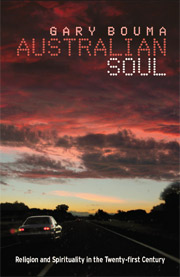Book contents
- Frontmatter
- Contents
- Tables and Figures
- Preface
- Acknowledgements
- 1 Introduction
- 2 Qualities of Australian religion and spirituality
- 3 Quantities of Australian religion and spirituality
- 4 Spirituality and cultural change
- 5 The changing social location of religion and spirituality
- 6 The mainstream: From Christendom to comfortable on the margins
- 7 Religion and spirituality respond to change
- 8 Religion, spirituality and Australian social policy
- 9 Signs of hope in the twenty-first century
- Further reading
- References
- Index
2 - Qualities of Australian religion and spirituality
Published online by Cambridge University Press: 05 June 2012
- Frontmatter
- Contents
- Tables and Figures
- Preface
- Acknowledgements
- 1 Introduction
- 2 Qualities of Australian religion and spirituality
- 3 Quantities of Australian religion and spirituality
- 4 Spirituality and cultural change
- 5 The changing social location of religion and spirituality
- 6 The mainstream: From Christendom to comfortable on the margins
- 7 Religion and spirituality respond to change
- 8 Religion, spirituality and Australian social policy
- 9 Signs of hope in the twenty-first century
- Further reading
- References
- Index
Summary
There is a distinctive quality to Australian religion and spirituality. This claim is made in the face of the fact that aside from the religious life of indigenous Australians, most of Australia's religious groups trace their origins to Ireland, the United Kingdom and Europe. Moreover, much of what passes for spirituality ‘down under’ has been imported from places overseas. Nonetheless, while Australian religion and spirituality is largely an amalgam of imported streams and strands, these are constructed and reproduced in distinctively Australian ways. There has been a resurgence of interest in the role of religious groups, organisations and beliefs in the emergence of this nation (e.g. Carey 1996; Breward 1993; Piggin 1996). These histories provide a corrective to those histories of Australia that follow the secular ideologies dominant at many universities, which ignore, or give little place to, the role of religion (e.g. Macintyre 2004; Grimshaw et al. 1994).
Indigenous Australians have been practising religion and spirituality for more than 40,000 years (Swain 1985). This rich diversity provides one historical frame for Australia's religious and spiritual life: it has always been diverse, respectful of the land, and attuned to the links between the here and now, and promoting responsibilities extending over generations and sharing. However, most Australians who identify themselves as Aboriginal also indicate that they are Christians. According to the 2001 Census, only 1.2 per cent of Aboriginal people said they held to their traditional religions whereas 69.0 per cent identified with a Christian denomination: 23 per cent each for Catholic and Anglican, 6 per cent Uniting and nearly 3 per cent each for Baptist, Lutheran and Pentecostal, 15.5 per cent claimed to have no religion and 10.9 per cent did not reply (Hughes 2004a).
- Type
- Chapter
- Information
- Australian SoulReligion and Spirituality in the 21st Century, pp. 31 - 48Publisher: Cambridge University PressPrint publication year: 2006



